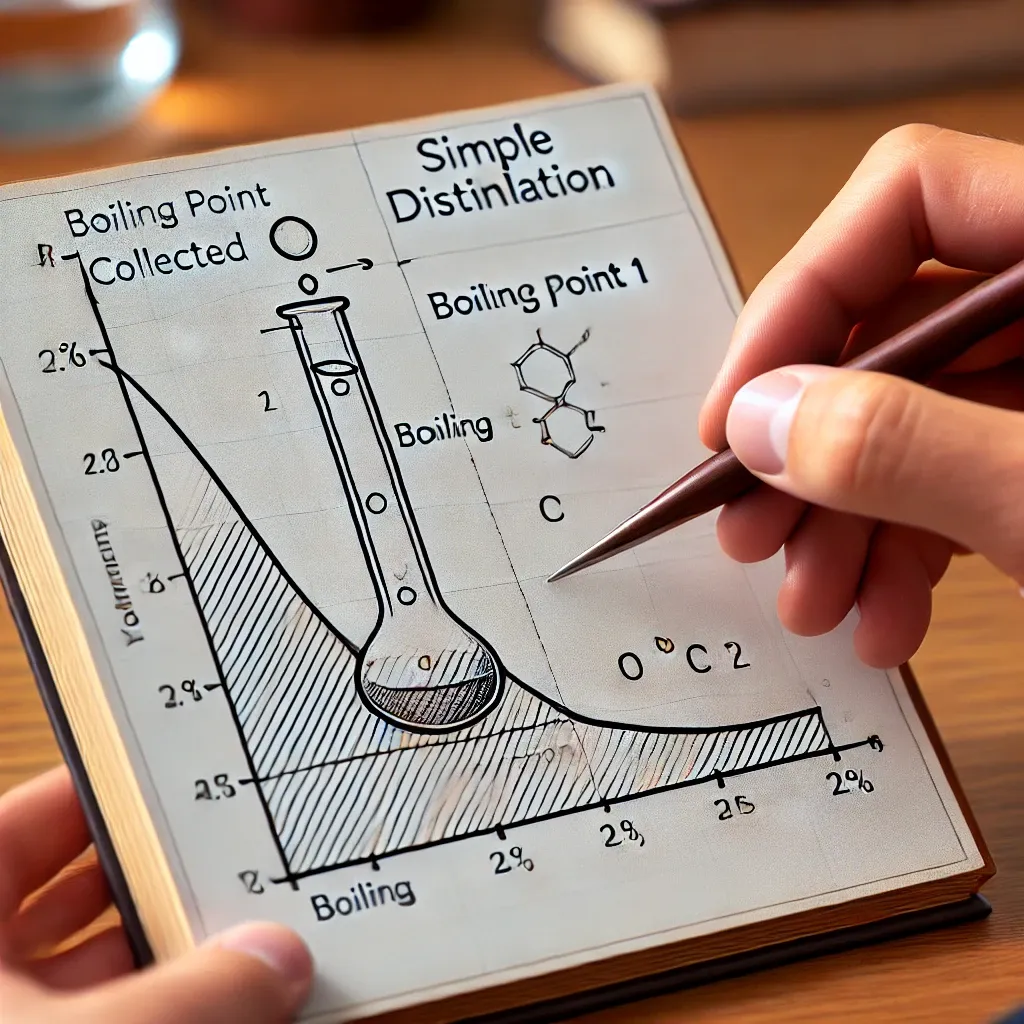Simple distillation is one of the most fundamental techniques used in chemistry to separate and purify liquids. This method is based on differences in boiling points and is commonly applied in laboratories for purifying water, isolating solvents, and refining essential oils. In this post, we'll break down the principle, apparatus, procedure, calculations, and distillation curve in a way that's easy to understand.
What is Simple Distillation?
Simple distillation is a physical process for separating a liquid from a mixture. It works on the principle that when a liquid is heated to its boiling point, it turns into vapour. This vapour is then cooled and condensed back into a liquid, leaving impurities or higher-boiling substances behind.
When to Use Simple Distillation?
This method is effective when:
✅
The liquids have at least a 50°C difference in boiling points.
✅
One component is significantly more volatile than the other.
✅
The mixture contains a non-volatile impurity (e.g., water with dissolved
salts).
Lab Apparatus for Simple Distillation
To perform simple distillation, you'll need the following
equipment:
- Round-bottom
Flask – Holds the liquid mixture.
- Bunsen
Burner or Heating Mantle – Heats the liquid.
- Thermometer
– Measures the vapor temperature.
- Distillation
Head – Connects the flask to the condenser.
- Liebig
Condenser – Cools and condenses the vapor.
- Receiving
Flask – Collects the purified liquid (distillate).
- Rubber
Tubing – Circulates cooling water in the condenser.
- Clamp
Stand & Support Rings – Holds the apparatus in place.
Step-by-Step Procedure for Simple Distillation
Step 1: Set Up the Apparatus
- Secure
the round-bottom flask on a stand.
- Attach
the thermometer just below the sidearm of the distillation head.
- Connect
the condenser to the water inlet and outlet, ensuring constant
water flow.
Step 2: Heating the Liquid
- Pour
the liquid mixture into the flask (not more than 2/3 full).
- Heat
gradually while monitoring the temperature.
- The
component with the lowest boiling point starts evaporating first.
Step 3: Condensing the Vapors
- The
vapour enters the Liebig condenser, where it cools and converts back
into liquid form.
- The
condensed liquid drips into the receiving flask.
Step 4: Collect the Distillate
- Continue
heating until the first fraction is completely distilled.
- Stop when the temperature suddenly rises, indicating the next component is about to distil.
Safety Tips & Lab Precautions
⚠ Never heat the flask to
dryness—it may cause overheating and glass breakage.
⚠ Ensure proper cooling water circulation in
the condenser.
⚠ Use a fume hood when working with volatile
substances.
⚠ Keep all joints sealed properly to prevent
vapor loss.
Calculations for Simple Distillation
1. Raoult’s Law (Vapor Pressure Contribution)
Where:
- = Vapor pressure of component
- = Mole fraction of component in the liquid phase
- = Vapor pressure of pure component
2. Dalton’s Law (Total Vapor Pressure)
Ptotal=P1+P2+P3+…
This means the total pressure is the sum of individual component pressures.
3. Distillation Yield (%)
Yield=(Initial Mass of MixtureMass of Distillate Collected)×100
This formula helps determine how efficient the distillation
process is.
Common Applications of Simple Distillation
✅ Water Purification –
Removing dissolved salts and impurities.
✅
Ethanol Distillation – Isolating alcohol from fermentation mixtures.
✅
Essential Oil Extraction – Distilling fragrances and medicinal oils.
✅
Petroleum Refining – Separating crude oil fractions.
FAQs on Simple Distillation
1. Can simple distillation separate alcohol from water?
Yes, but only to a certain extent. Ethanol (boiling
point ~78°C) and water (boiling point ~100°C) have close boiling points, making
fractional distillation a better choice.
2. Why is the condenser kept at an angle in distillation?
The condenser is placed slightly downward so that the
condensed liquid flows smoothly into the receiving flask without obstruction.
3. What happens if the distillation setup is not sealed correctly?
If there are leaks, vapours will escape, reducing
yield and possibly causing safety hazards if volatile substances are involved.
4. Can you distil salt water to make drinking water?
Yes! Simple distillation removes salt from seawater,
producing purified water. However, large-scale desalination usually uses reverse
osmosis instead.


